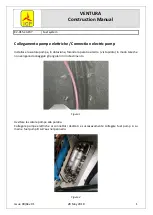
15
you should attend lessons, which are carried out and supervised by a
qualified instructor over water. Extreme manoeuvres take you and your
wing to centrifugal forces that can reach 4 to 5g.
Materials will wear more quickly than in normal flight. If you do practice
extreme manoeuvres we recommend that you submit your wing to a line
revision every six months.
7. CARE AND MAINTENANCE
7.1 MAINTENANCE
Careful maintenance of your equipment will ensure continued
performance. Always check all the flying equipment before every flight.
Careful maintenance of your equipment will ensure continued
performance. The fabric and the lines do not need to be washed, if they
become dirty, clean them with a soft damp cloth.
If your wing gets wet with salty water, immerse it in fresh water and dry it
away from direct sunlight. The sunlight may damage the materials of your
wing and cause premature aging. Once you have landed, do not leave
the wing in the sun, store it properly.
If you use your wing in a sandy area, try to avoid the sand from entering
through the cell openings of the leading edge. If sand is inside the wing,
remove it before folding.
If it gets wet of sea water, you should submerge it into fresh water and let
it dry far away from the sun.
7.2 STORAGE
It is important that the wing is correctly folded when stored. Store your
flying equipment in a cool, dry place away from solvents, fuels or oils. It
is not advisable to store your flying equipment in the trunk of your car.
Temperatures inside a car parked in the sunlight, can be very high. Inside
a rucksack and in the sunlight temperatures can reach 60ºC. Weight
should not be laid on top of the equipment.
If the flying gear is stored with organic material (such as leaves or insects)
inside, the chemical reaction can cause irreparable damage.
7.3 CHECKS AND CONTROLS
You should ensure your ARTIK 4 is periodically serviced and checked
at your local repair shop every 100 hours of use or every 24 months
(whichever happens first). This is the only way to guarantee that your
ARTIK 4 will continue to function properly and therefore continue fulfilling
the homologation certificate results.
In spite of providing much more benefits to the pilots, gliders equipped
with unsheathed lines need more care and control of the calibration. The
ARTIK 4 mechanic and UV resistance are one of the highest for this type
of line. With this gliders every little variation on the calibration of the lines
has a directly effect on the performance of the wing.
We recommend checking the lines calibration after the first 30 hours
+/- of flight. This line check is a separate procedure from the regular
inspection after each subsequent 100 hours of use or every two years
(whichever happens first).
Why is it necessary?
Due to the experience acquired over time, constant controls and
inspections conducted by our R&D department in regard to the Abac
Team gliders, we are now able to predict gear aging and how to
appropriately take care of this kind of lines, thus keeping the wing profile
in top performing condition. Following the recommended glider service







































